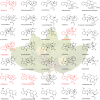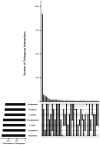The Mitragyna speciosa (Kratom) Genome: a resource for data-mining potent pharmaceuticals that impact human health
- PMID: 33677570
- PMCID: PMC8759815
- DOI: 10.1093/g3journal/jkab058
The Mitragyna speciosa (Kratom) Genome: a resource for data-mining potent pharmaceuticals that impact human health
Abstract
Mitragyna speciosa (kratom) produces numerous compounds with pharmaceutical properties including the production of bioactive monoterpene indole and oxindole alkaloids. Using a linked-read approach, a 1,122,519,462 bp draft assembly of M. speciosa "Rifat" was generated with an N50 scaffold size of 1,020,971 bp and an N50 contig size of 70,448 bp that encodes 55,746 genes. Chromosome counting revealed that "Rifat" is a tetraploid with a base chromosome number of 11, which was further corroborated by orthology and syntenic analysis of the genome. Analysis of genes and clusters involved in specialized metabolism revealed genes putatively involved in alkaloid biosynthesis. Access to the genome of M. speciosa will facilitate an improved understanding of alkaloid biosynthesis and accelerate the production of bioactive alkaloids in heterologous hosts.
Keywords: Mitragyna speciosa; alkaloids; genome; kratom; linked-read assembly.
© The Author(s) 2021. Published by Oxford University Press on behalf of Genetics Society of America.
Figures





Similar articles
-
Kratom (Mitragyna speciosa) Validation: Quantitative Analysis of Indole and Oxindole Alkaloids Reveals Chemotypes of Plants and Products.Planta Med. 2022 Aug;88(9-10):838-857. doi: 10.1055/a-1795-5876. Epub 2022 Apr 25. Planta Med. 2022. PMID: 35468648 Free PMC article.
-
Metabolite and Molecular Characterization of Mitragyna speciosa Identifies Developmental and Genotypic Effects on Monoterpene Indole and Oxindole Alkaloid Composition.J Nat Prod. 2023 Apr 28;86(4):1042-1052. doi: 10.1021/acs.jnatprod.3c00092. Epub 2023 Mar 13. J Nat Prod. 2023. PMID: 36913648
-
Biosynthesis of kratom opioids.New Phytol. 2023 Oct;240(2):757-769. doi: 10.1111/nph.19162. Epub 2023 Jul 30. New Phytol. 2023. PMID: 37518950
-
Chemical, pharmacological properties and biosynthesis of opioid mitragynine in Mitragyna speciosa (kratom).Curr Opin Plant Biol. 2024 Oct;81:102600. doi: 10.1016/j.pbi.2024.102600. Epub 2024 Jul 12. Curr Opin Plant Biol. 2024. PMID: 39002353 Review.
-
Pharmacokinetics and pharmacodynamics of mitragynine, the principle alkaloid of Mitragyna speciosa: present knowledge and future directions in perspective of pain.J Basic Clin Physiol Pharmacol. 2019 Oct 30;31(1). doi: 10.1515/jbcpp-2019-0138. J Basic Clin Physiol Pharmacol. 2019. PMID: 31665120 Review.
Cited by
-
Utilizing Plant Synthetic Biology to Improve Human Health and Wellness.Front Plant Sci. 2021 Aug 24;12:691462. doi: 10.3389/fpls.2021.691462. eCollection 2021. Front Plant Sci. 2021. PMID: 34504505 Free PMC article. Review.
-
Genome Assembly of the Medicinal Plant Voacanga thouarsii.Genome Biol Evol. 2022 Nov 4;14(11):evac158. doi: 10.1093/gbe/evac158. Genome Biol Evol. 2022. PMID: 36300641 Free PMC article.
-
Discovery and Characterization of Oxidative Enzymes Involved in Monoterpenoid Indole Alkaloid Biosynthesis.Methods Mol Biol. 2022;2505:141-164. doi: 10.1007/978-1-0716-2349-7_11. Methods Mol Biol. 2022. PMID: 35732943
-
Comparative Mitogenomic Analysis Reveals Gene and Intron Dynamics in Rubiaceae and Intra-Specific Diversification in Damnacanthus indicus.Int J Mol Sci. 2021 Jul 5;22(13):7237. doi: 10.3390/ijms22137237. Int J Mol Sci. 2021. PMID: 34281291 Free PMC article.
-
Genome mining of metabolic gene clusters in the Rubiaceae family.Comput Struct Biotechnol J. 2023 Nov 20;23:22-33. doi: 10.1016/j.csbj.2023.11.034. eCollection 2024 Dec. Comput Struct Biotechnol J. 2023. PMID: 38075396 Free PMC article.
References
-
- Adkins JE, Boyer EW, McCurdy CR.. 2011. Mitragyna speciosa, a psychoactive tree from Southeast Asia with opioid activity. Curr Top Med Chem. 11:1165–1175. - PubMed
-
- Argout X, Salse J, Aury JM, Guiltinan MJ, Droc G, et al. 2011. The genome of Theobroma cacao. Nat Genet. 43:101–108. - PubMed
-
- Bacher N, Tiefenthaler M, Sturm S, Stuppner H, Ausserlechner MJ, et al. 2006. Oxindole alkaloids from Uncaria tomentosa induce apoptosis in proliferating, G0/G1-arrested and bcl-2-expressing acute lymphoblastic leukaemia cells. Br J Haematol. 132:615–622. - PubMed
-
- Bigliani MC, Rosso MC, Zunino PM, Baiardi G, Ponce AA.. 2013. Anxiogenic-like effects of Uncaria tomentosa (Willd.) DC. aqueous extract in an elevated plus maze test in mice: a preliminary study. Nat Prod Res. 27:1682–1685. - PubMed
Publication types
MeSH terms
Substances
Associated data
LinkOut - more resources
Full Text Sources
Other Literature Sources
